IT Systems Failure: ERP Failures, Factors, and Mitigation Strategies
VerifiedAdded on 2021/05/31
|12
|2689
|78
Report
AI Summary
This report provides an analysis of IT system failures, with a specific focus on ERP (Enterprise Resource Planning) systems. It begins with an executive summary and table of contents, then introduces the topic by explaining how failures occur due to software or hardware issues. The report delves into the failure of ERP systems, drawing from case studies by Barker and Frolick, and Feghali and Zbib. It identifies critical factors contributing to ERP failures, including interaction, process, and correspondence failures. The report also explores four key factors behind ERP failure: domain, user views, organizational, and interference failures, and discusses the problems associated with each. Furthermore, it examines the most critical failures related to cultural, managerial, and technological scenarios. The report emphasizes the importance of proper team attitude, complete backing from everyone involved, and the need to view ERP implementation as a business endeavor. The study also highlights the impact of technical, cultural, and managerial failures, providing insights into the complex nature of IT system implementations and offering strategies for mitigation.
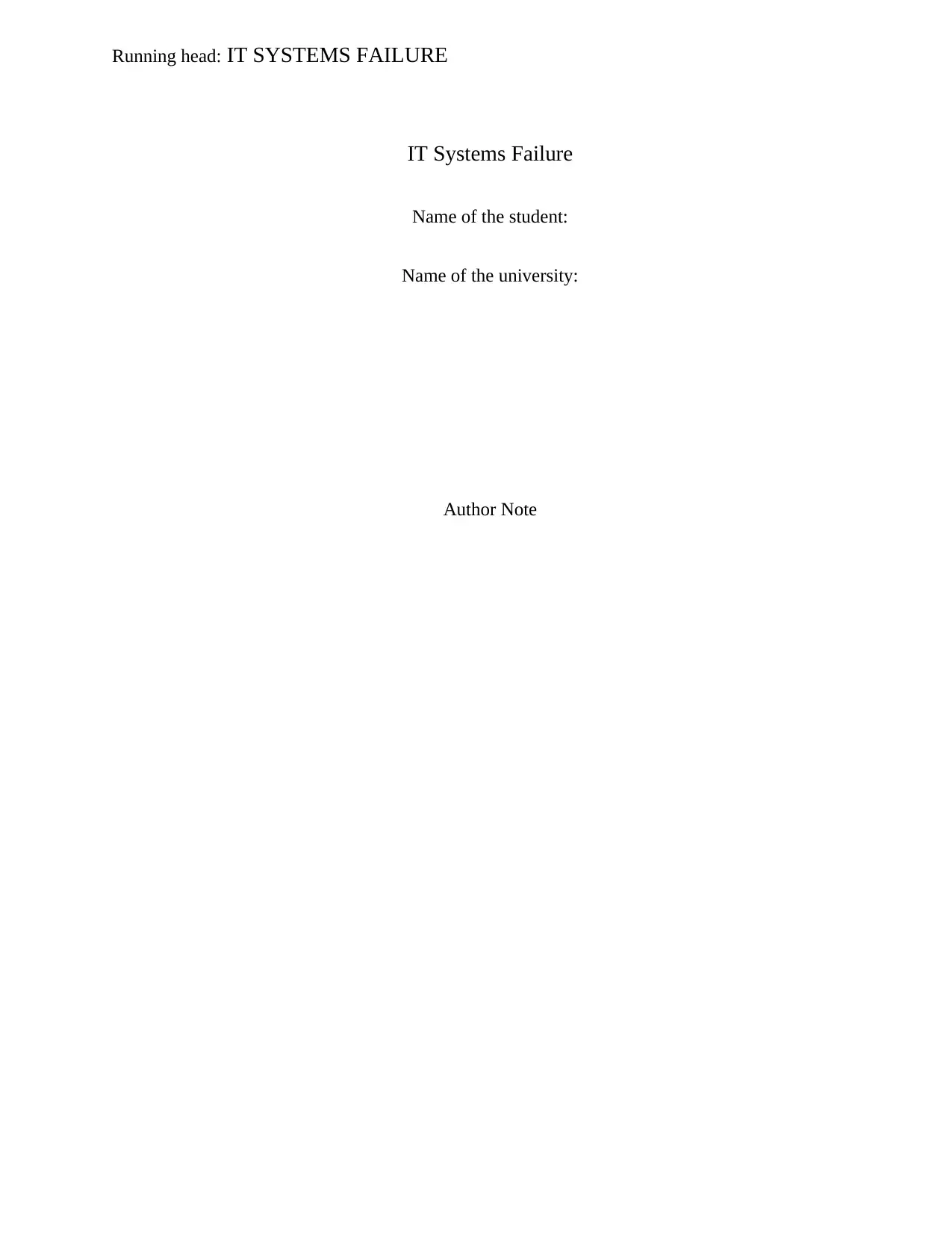
Running head: IT SYSTEMS FAILURE
IT Systems Failure
Name of the student:
Name of the university:
Author Note
IT Systems Failure
Name of the student:
Name of the university:
Author Note
Paraphrase This Document
Need a fresh take? Get an instant paraphrase of this document with our AI Paraphraser
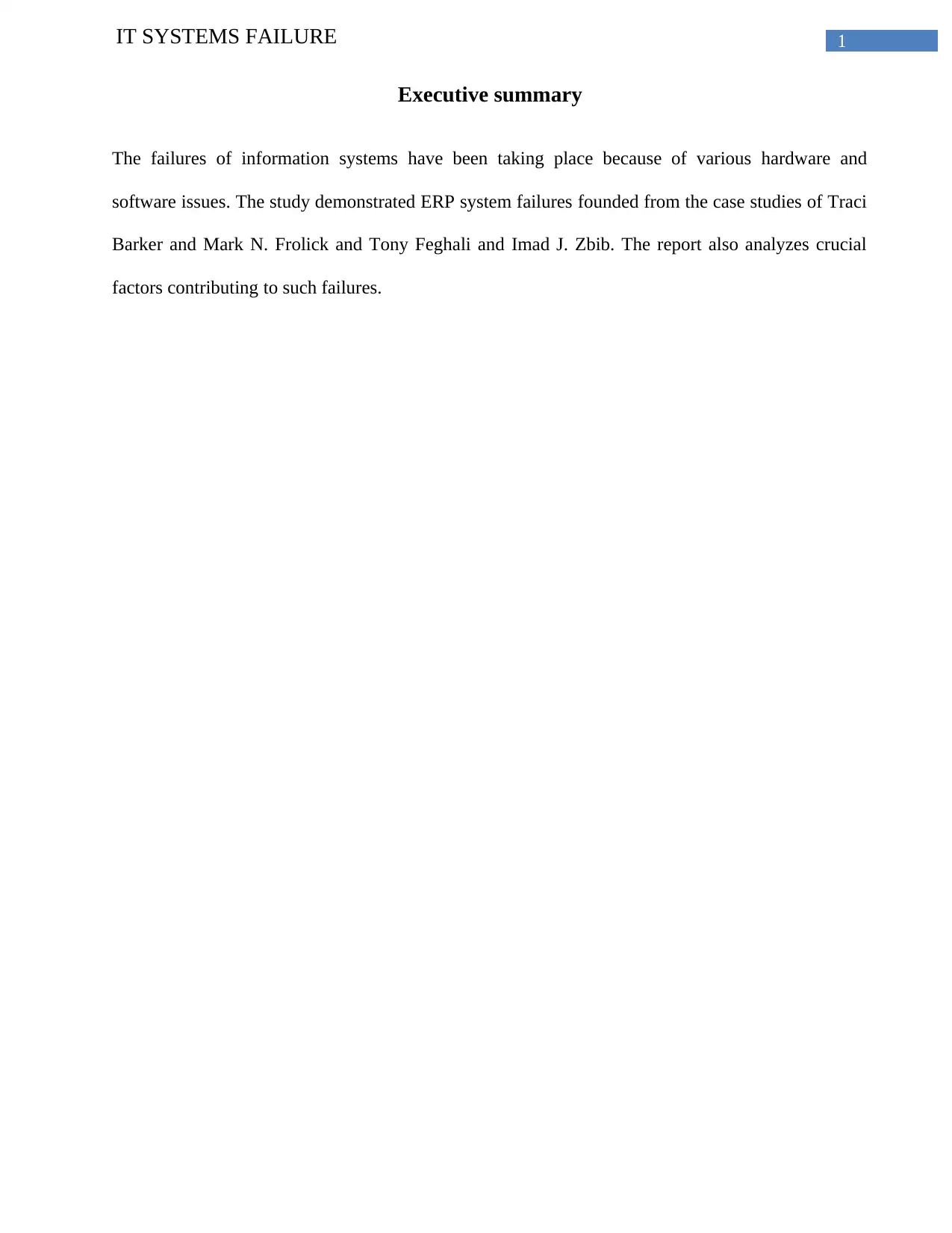
1IT SYSTEMS FAILURE
Executive summary
The failures of information systems have been taking place because of various hardware and
software issues. The study demonstrated ERP system failures founded from the case studies of Traci
Barker and Mark N. Frolick and Tony Feghali and Imad J. Zbib. The report also analyzes crucial
factors contributing to such failures.
Executive summary
The failures of information systems have been taking place because of various hardware and
software issues. The study demonstrated ERP system failures founded from the case studies of Traci
Barker and Mark N. Frolick and Tony Feghali and Imad J. Zbib. The report also analyzes crucial
factors contributing to such failures.
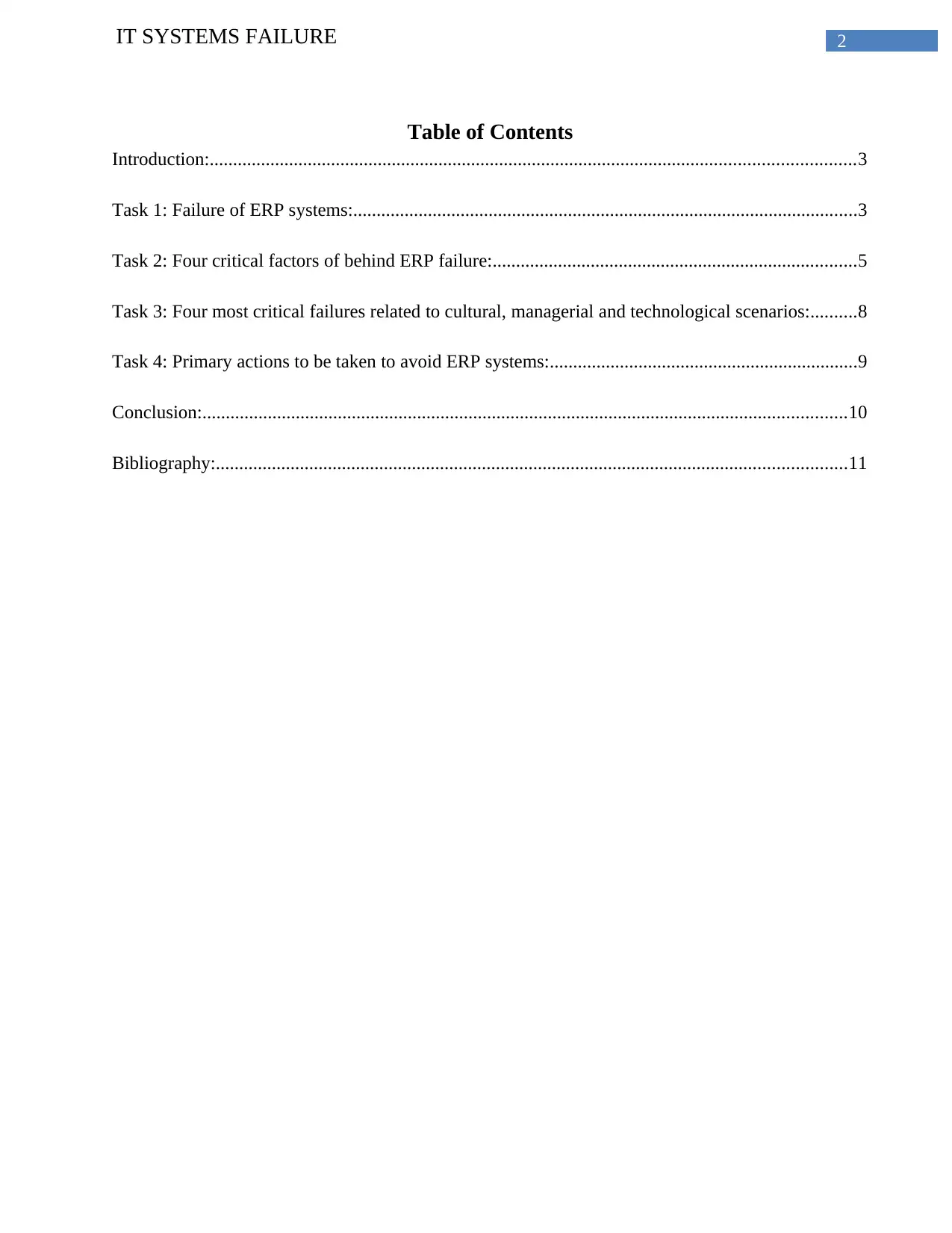
2IT SYSTEMS FAILURE
Table of Contents
Introduction:..........................................................................................................................................3
Task 1: Failure of ERP systems:............................................................................................................3
Task 2: Four critical factors of behind ERP failure:..............................................................................5
Task 3: Four most critical failures related to cultural, managerial and technological scenarios:..........8
Task 4: Primary actions to be taken to avoid ERP systems:..................................................................9
Conclusion:..........................................................................................................................................10
Bibliography:.......................................................................................................................................11
Table of Contents
Introduction:..........................................................................................................................................3
Task 1: Failure of ERP systems:............................................................................................................3
Task 2: Four critical factors of behind ERP failure:..............................................................................5
Task 3: Four most critical failures related to cultural, managerial and technological scenarios:..........8
Task 4: Primary actions to be taken to avoid ERP systems:..................................................................9
Conclusion:..........................................................................................................................................10
Bibliography:.......................................................................................................................................11
⊘ This is a preview!⊘
Do you want full access?
Subscribe today to unlock all pages.

Trusted by 1+ million students worldwide
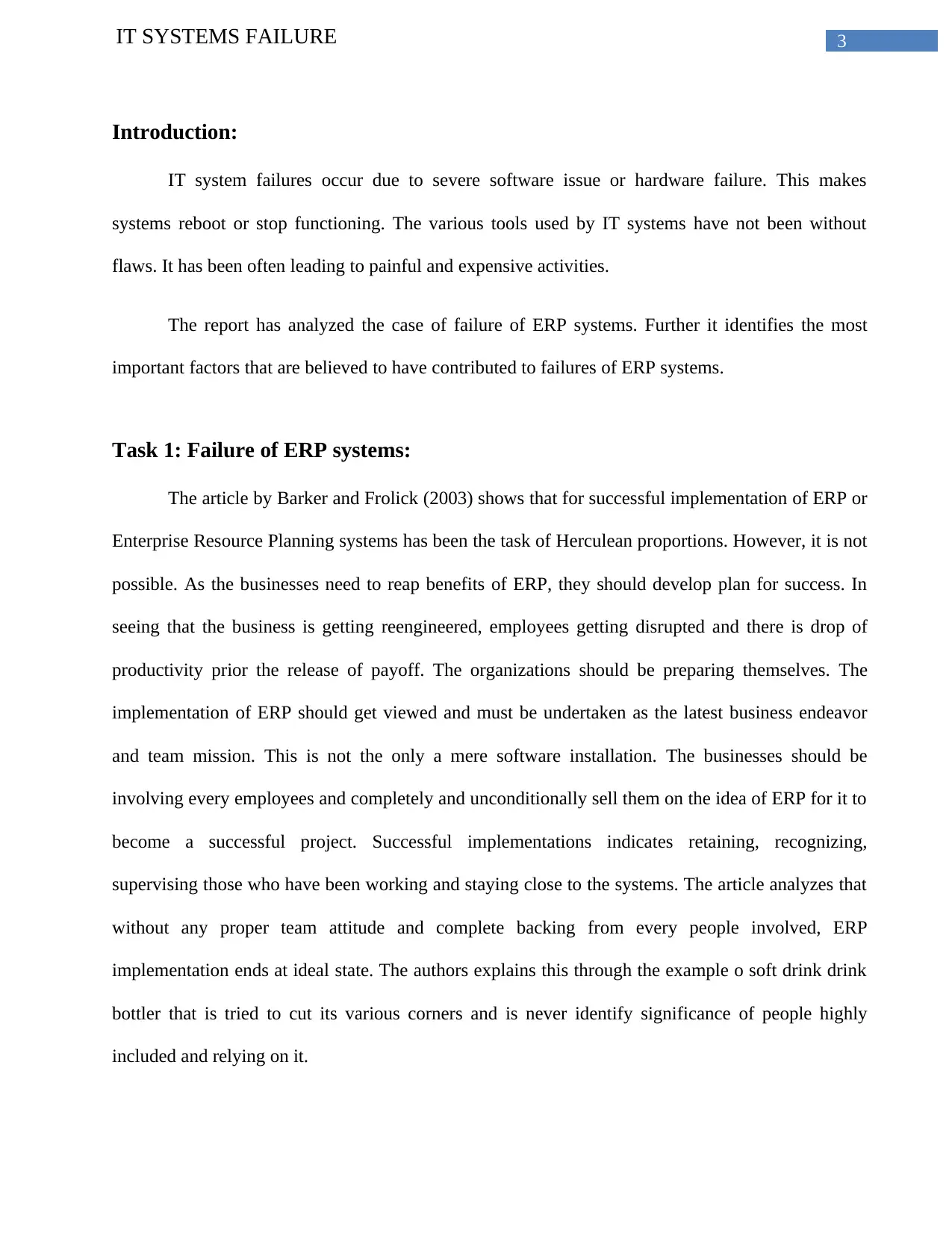
3IT SYSTEMS FAILURE
Introduction:
IT system failures occur due to severe software issue or hardware failure. This makes
systems reboot or stop functioning. The various tools used by IT systems have not been without
flaws. It has been often leading to painful and expensive activities.
The report has analyzed the case of failure of ERP systems. Further it identifies the most
important factors that are believed to have contributed to failures of ERP systems.
Task 1: Failure of ERP systems:
The article by Barker and Frolick (2003) shows that for successful implementation of ERP or
Enterprise Resource Planning systems has been the task of Herculean proportions. However, it is not
possible. As the businesses need to reap benefits of ERP, they should develop plan for success. In
seeing that the business is getting reengineered, employees getting disrupted and there is drop of
productivity prior the release of payoff. The organizations should be preparing themselves. The
implementation of ERP should get viewed and must be undertaken as the latest business endeavor
and team mission. This is not the only a mere software installation. The businesses should be
involving every employees and completely and unconditionally sell them on the idea of ERP for it to
become a successful project. Successful implementations indicates retaining, recognizing,
supervising those who have been working and staying close to the systems. The article analyzes that
without any proper team attitude and complete backing from every people involved, ERP
implementation ends at ideal state. The authors explains this through the example o soft drink drink
bottler that is tried to cut its various corners and is never identify significance of people highly
included and relying on it.
Introduction:
IT system failures occur due to severe software issue or hardware failure. This makes
systems reboot or stop functioning. The various tools used by IT systems have not been without
flaws. It has been often leading to painful and expensive activities.
The report has analyzed the case of failure of ERP systems. Further it identifies the most
important factors that are believed to have contributed to failures of ERP systems.
Task 1: Failure of ERP systems:
The article by Barker and Frolick (2003) shows that for successful implementation of ERP or
Enterprise Resource Planning systems has been the task of Herculean proportions. However, it is not
possible. As the businesses need to reap benefits of ERP, they should develop plan for success. In
seeing that the business is getting reengineered, employees getting disrupted and there is drop of
productivity prior the release of payoff. The organizations should be preparing themselves. The
implementation of ERP should get viewed and must be undertaken as the latest business endeavor
and team mission. This is not the only a mere software installation. The businesses should be
involving every employees and completely and unconditionally sell them on the idea of ERP for it to
become a successful project. Successful implementations indicates retaining, recognizing,
supervising those who have been working and staying close to the systems. The article analyzes that
without any proper team attitude and complete backing from every people involved, ERP
implementation ends at ideal state. The authors explains this through the example o soft drink drink
bottler that is tried to cut its various corners and is never identify significance of people highly
included and relying on it.
Paraphrase This Document
Need a fresh take? Get an instant paraphrase of this document with our AI Paraphraser

4IT SYSTEMS FAILURE
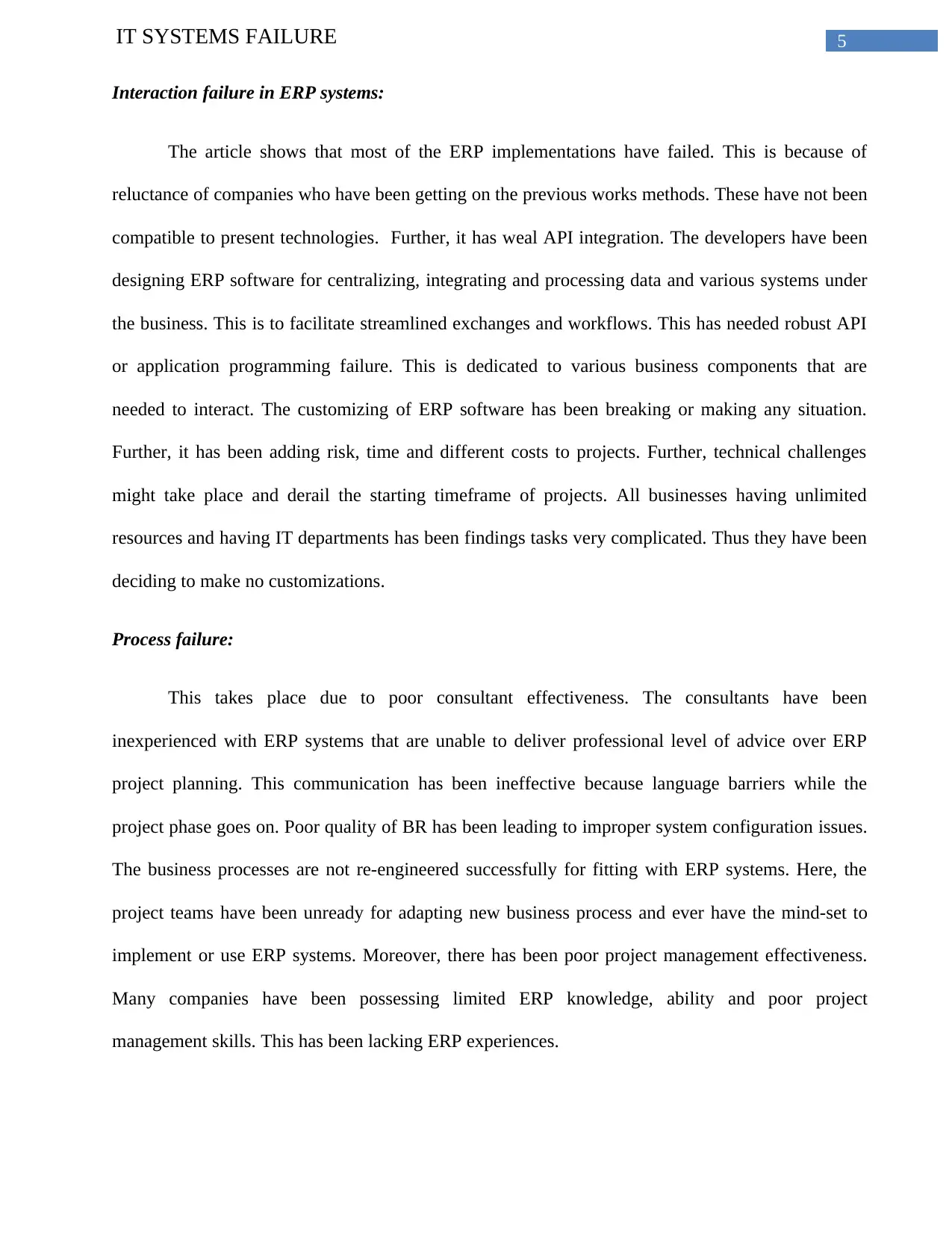
5IT SYSTEMS FAILURE
Interaction failure in ERP systems:
The article shows that most of the ERP implementations have failed. This is because of
reluctance of companies who have been getting on the previous works methods. These have not been
compatible to present technologies. Further, it has weal API integration. The developers have been
designing ERP software for centralizing, integrating and processing data and various systems under
the business. This is to facilitate streamlined exchanges and workflows. This has needed robust API
or application programming failure. This is dedicated to various business components that are
needed to interact. The customizing of ERP software has been breaking or making any situation.
Further, it has been adding risk, time and different costs to projects. Further, technical challenges
might take place and derail the starting timeframe of projects. All businesses having unlimited
resources and having IT departments has been findings tasks very complicated. Thus they have been
deciding to make no customizations.
Process failure:
This takes place due to poor consultant effectiveness. The consultants have been
inexperienced with ERP systems that are unable to deliver professional level of advice over ERP
project planning. This communication has been ineffective because language barriers while the
project phase goes on. Poor quality of BR has been leading to improper system configuration issues.
The business processes are not re-engineered successfully for fitting with ERP systems. Here, the
project teams have been unready for adapting new business process and ever have the mind-set to
implement or use ERP systems. Moreover, there has been poor project management effectiveness.
Many companies have been possessing limited ERP knowledge, ability and poor project
management skills. This has been lacking ERP experiences.
Interaction failure in ERP systems:
The article shows that most of the ERP implementations have failed. This is because of
reluctance of companies who have been getting on the previous works methods. These have not been
compatible to present technologies. Further, it has weal API integration. The developers have been
designing ERP software for centralizing, integrating and processing data and various systems under
the business. This is to facilitate streamlined exchanges and workflows. This has needed robust API
or application programming failure. This is dedicated to various business components that are
needed to interact. The customizing of ERP software has been breaking or making any situation.
Further, it has been adding risk, time and different costs to projects. Further, technical challenges
might take place and derail the starting timeframe of projects. All businesses having unlimited
resources and having IT departments has been findings tasks very complicated. Thus they have been
deciding to make no customizations.
Process failure:
This takes place due to poor consultant effectiveness. The consultants have been
inexperienced with ERP systems that are unable to deliver professional level of advice over ERP
project planning. This communication has been ineffective because language barriers while the
project phase goes on. Poor quality of BR has been leading to improper system configuration issues.
The business processes are not re-engineered successfully for fitting with ERP systems. Here, the
project teams have been unready for adapting new business process and ever have the mind-set to
implement or use ERP systems. Moreover, there has been poor project management effectiveness.
Many companies have been possessing limited ERP knowledge, ability and poor project
management skills. This has been lacking ERP experiences.
⊘ This is a preview!⊘
Do you want full access?
Subscribe today to unlock all pages.

Trusted by 1+ million students worldwide
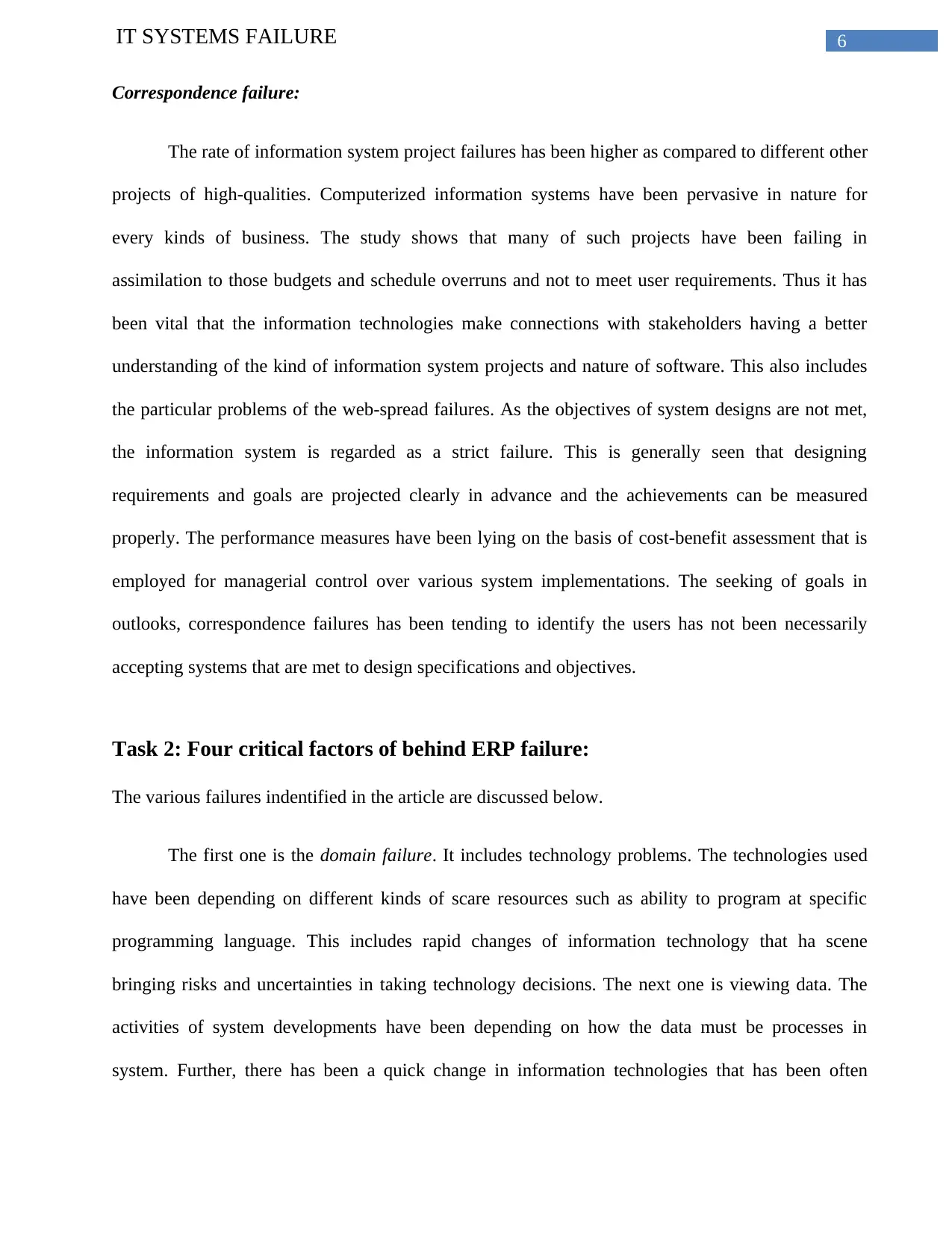
6IT SYSTEMS FAILURE
Correspondence failure:
The rate of information system project failures has been higher as compared to different other
projects of high-qualities. Computerized information systems have been pervasive in nature for
every kinds of business. The study shows that many of such projects have been failing in
assimilation to those budgets and schedule overruns and not to meet user requirements. Thus it has
been vital that the information technologies make connections with stakeholders having a better
understanding of the kind of information system projects and nature of software. This also includes
the particular problems of the web-spread failures. As the objectives of system designs are not met,
the information system is regarded as a strict failure. This is generally seen that designing
requirements and goals are projected clearly in advance and the achievements can be measured
properly. The performance measures have been lying on the basis of cost-benefit assessment that is
employed for managerial control over various system implementations. The seeking of goals in
outlooks, correspondence failures has been tending to identify the users has not been necessarily
accepting systems that are met to design specifications and objectives.
Task 2: Four critical factors of behind ERP failure:
The various failures indentified in the article are discussed below.
The first one is the domain failure. It includes technology problems. The technologies used
have been depending on different kinds of scare resources such as ability to program at specific
programming language. This includes rapid changes of information technology that ha scene
bringing risks and uncertainties in taking technology decisions. The next one is viewing data. The
activities of system developments have been depending on how the data must be processes in
system. Further, there has been a quick change in information technologies that has been often
Correspondence failure:
The rate of information system project failures has been higher as compared to different other
projects of high-qualities. Computerized information systems have been pervasive in nature for
every kinds of business. The study shows that many of such projects have been failing in
assimilation to those budgets and schedule overruns and not to meet user requirements. Thus it has
been vital that the information technologies make connections with stakeholders having a better
understanding of the kind of information system projects and nature of software. This also includes
the particular problems of the web-spread failures. As the objectives of system designs are not met,
the information system is regarded as a strict failure. This is generally seen that designing
requirements and goals are projected clearly in advance and the achievements can be measured
properly. The performance measures have been lying on the basis of cost-benefit assessment that is
employed for managerial control over various system implementations. The seeking of goals in
outlooks, correspondence failures has been tending to identify the users has not been necessarily
accepting systems that are met to design specifications and objectives.
Task 2: Four critical factors of behind ERP failure:
The various failures indentified in the article are discussed below.
The first one is the domain failure. It includes technology problems. The technologies used
have been depending on different kinds of scare resources such as ability to program at specific
programming language. This includes rapid changes of information technology that ha scene
bringing risks and uncertainties in taking technology decisions. The next one is viewing data. The
activities of system developments have been depending on how the data must be processes in
system. Further, there has been a quick change in information technologies that has been often
Paraphrase This Document
Need a fresh take? Get an instant paraphrase of this document with our AI Paraphraser
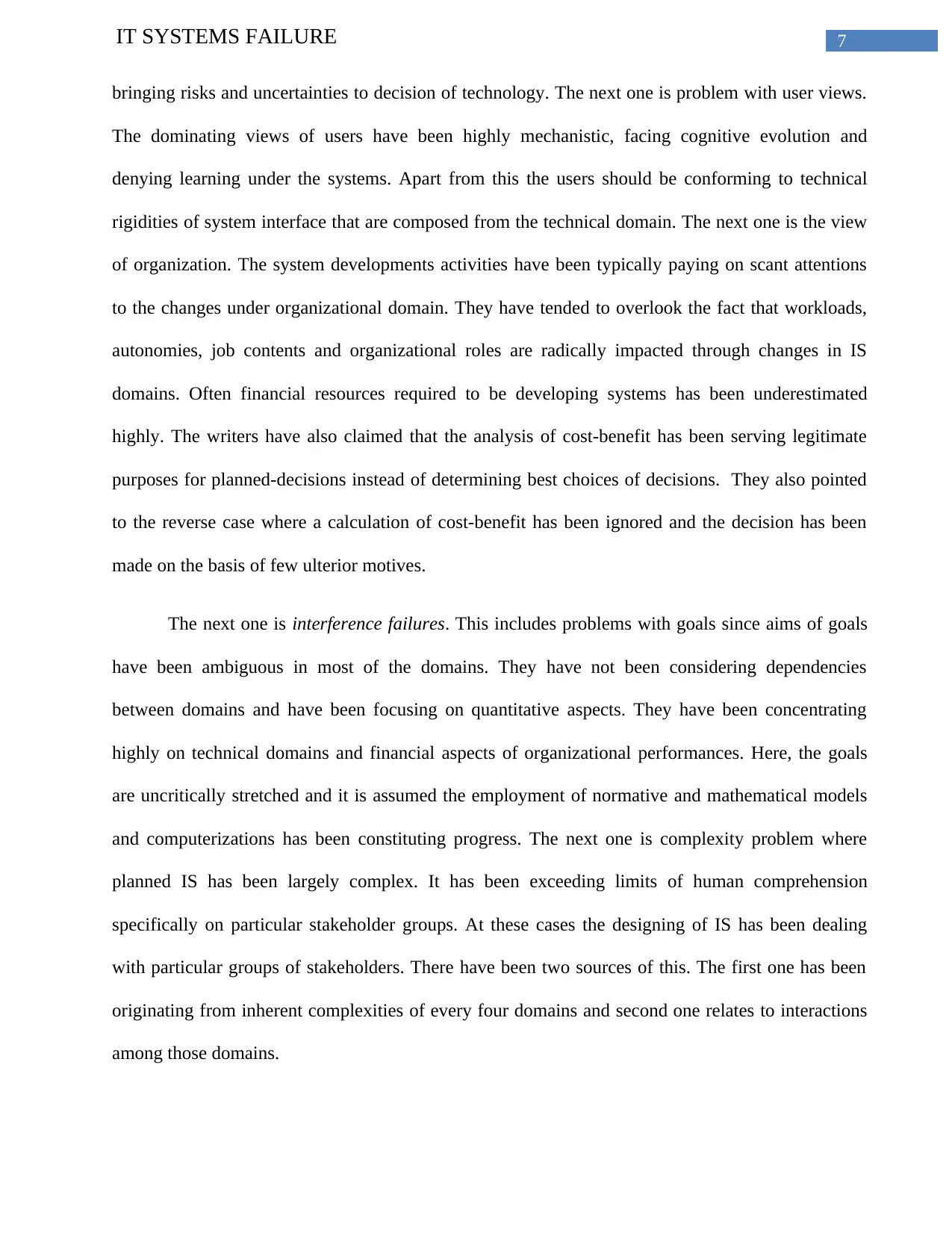
7IT SYSTEMS FAILURE
bringing risks and uncertainties to decision of technology. The next one is problem with user views.
The dominating views of users have been highly mechanistic, facing cognitive evolution and
denying learning under the systems. Apart from this the users should be conforming to technical
rigidities of system interface that are composed from the technical domain. The next one is the view
of organization. The system developments activities have been typically paying on scant attentions
to the changes under organizational domain. They have tended to overlook the fact that workloads,
autonomies, job contents and organizational roles are radically impacted through changes in IS
domains. Often financial resources required to be developing systems has been underestimated
highly. The writers have also claimed that the analysis of cost-benefit has been serving legitimate
purposes for planned-decisions instead of determining best choices of decisions. They also pointed
to the reverse case where a calculation of cost-benefit has been ignored and the decision has been
made on the basis of few ulterior motives.
The next one is interference failures. This includes problems with goals since aims of goals
have been ambiguous in most of the domains. They have not been considering dependencies
between domains and have been focusing on quantitative aspects. They have been concentrating
highly on technical domains and financial aspects of organizational performances. Here, the goals
are uncritically stretched and it is assumed the employment of normative and mathematical models
and computerizations has been constituting progress. The next one is complexity problem where
planned IS has been largely complex. It has been exceeding limits of human comprehension
specifically on particular stakeholder groups. At these cases the designing of IS has been dealing
with particular groups of stakeholders. There have been two sources of this. The first one has been
originating from inherent complexities of every four domains and second one relates to interactions
among those domains.
bringing risks and uncertainties to decision of technology. The next one is problem with user views.
The dominating views of users have been highly mechanistic, facing cognitive evolution and
denying learning under the systems. Apart from this the users should be conforming to technical
rigidities of system interface that are composed from the technical domain. The next one is the view
of organization. The system developments activities have been typically paying on scant attentions
to the changes under organizational domain. They have tended to overlook the fact that workloads,
autonomies, job contents and organizational roles are radically impacted through changes in IS
domains. Often financial resources required to be developing systems has been underestimated
highly. The writers have also claimed that the analysis of cost-benefit has been serving legitimate
purposes for planned-decisions instead of determining best choices of decisions. They also pointed
to the reverse case where a calculation of cost-benefit has been ignored and the decision has been
made on the basis of few ulterior motives.
The next one is interference failures. This includes problems with goals since aims of goals
have been ambiguous in most of the domains. They have not been considering dependencies
between domains and have been focusing on quantitative aspects. They have been concentrating
highly on technical domains and financial aspects of organizational performances. Here, the goals
are uncritically stretched and it is assumed the employment of normative and mathematical models
and computerizations has been constituting progress. The next one is complexity problem where
planned IS has been largely complex. It has been exceeding limits of human comprehension
specifically on particular stakeholder groups. At these cases the designing of IS has been dealing
with particular groups of stakeholders. There have been two sources of this. The first one has been
originating from inherent complexities of every four domains and second one relates to interactions
among those domains.
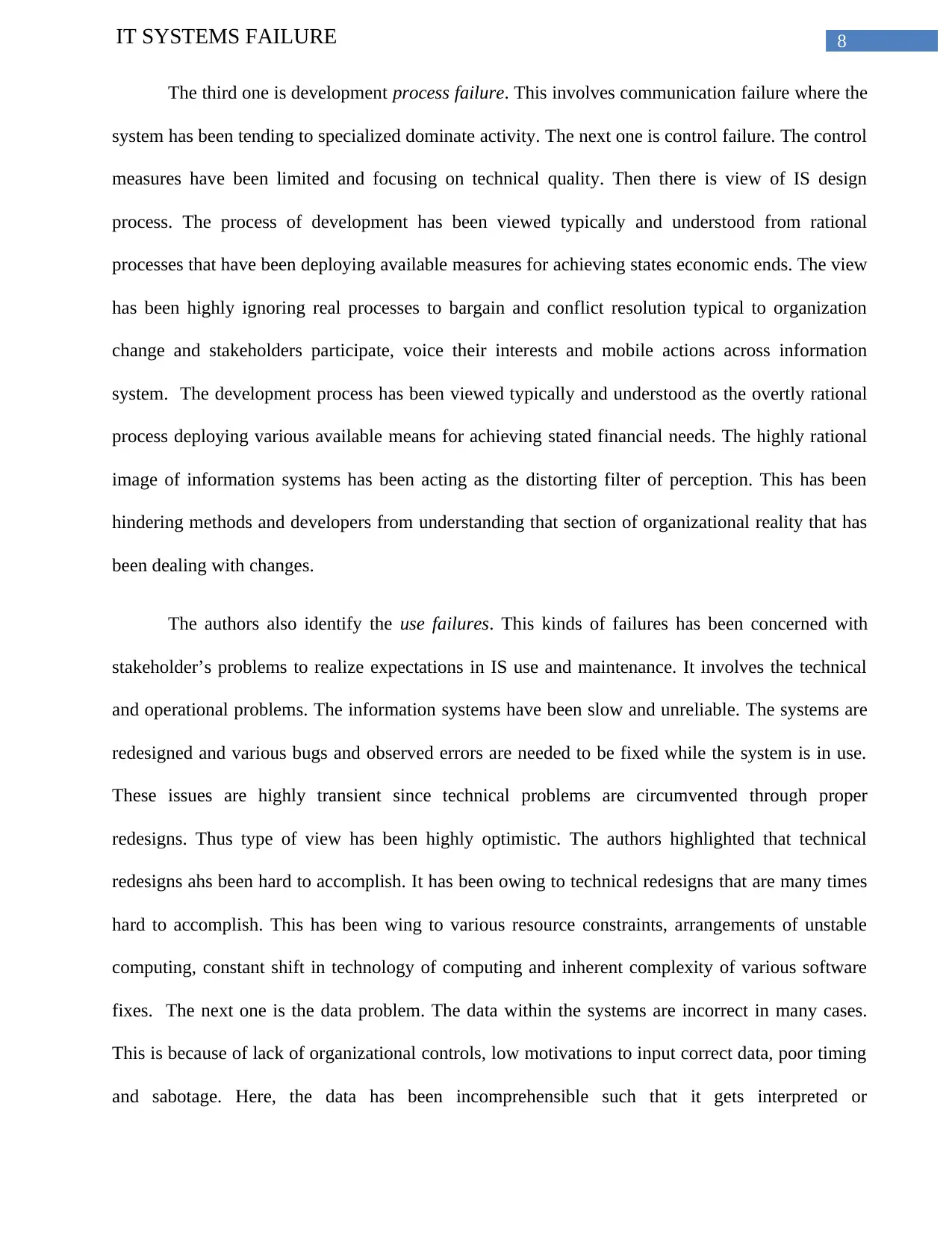
8IT SYSTEMS FAILURE
The third one is development process failure. This involves communication failure where the
system has been tending to specialized dominate activity. The next one is control failure. The control
measures have been limited and focusing on technical quality. Then there is view of IS design
process. The process of development has been viewed typically and understood from rational
processes that have been deploying available measures for achieving states economic ends. The view
has been highly ignoring real processes to bargain and conflict resolution typical to organization
change and stakeholders participate, voice their interests and mobile actions across information
system. The development process has been viewed typically and understood as the overtly rational
process deploying various available means for achieving stated financial needs. The highly rational
image of information systems has been acting as the distorting filter of perception. This has been
hindering methods and developers from understanding that section of organizational reality that has
been dealing with changes.
The authors also identify the use failures. This kinds of failures has been concerned with
stakeholder’s problems to realize expectations in IS use and maintenance. It involves the technical
and operational problems. The information systems have been slow and unreliable. The systems are
redesigned and various bugs and observed errors are needed to be fixed while the system is in use.
These issues are highly transient since technical problems are circumvented through proper
redesigns. Thus type of view has been highly optimistic. The authors highlighted that technical
redesigns ahs been hard to accomplish. It has been owing to technical redesigns that are many times
hard to accomplish. This has been wing to various resource constraints, arrangements of unstable
computing, constant shift in technology of computing and inherent complexity of various software
fixes. The next one is the data problem. The data within the systems are incorrect in many cases.
This is because of lack of organizational controls, low motivations to input correct data, poor timing
and sabotage. Here, the data has been incomprehensible such that it gets interpreted or
The third one is development process failure. This involves communication failure where the
system has been tending to specialized dominate activity. The next one is control failure. The control
measures have been limited and focusing on technical quality. Then there is view of IS design
process. The process of development has been viewed typically and understood from rational
processes that have been deploying available measures for achieving states economic ends. The view
has been highly ignoring real processes to bargain and conflict resolution typical to organization
change and stakeholders participate, voice their interests and mobile actions across information
system. The development process has been viewed typically and understood as the overtly rational
process deploying various available means for achieving stated financial needs. The highly rational
image of information systems has been acting as the distorting filter of perception. This has been
hindering methods and developers from understanding that section of organizational reality that has
been dealing with changes.
The authors also identify the use failures. This kinds of failures has been concerned with
stakeholder’s problems to realize expectations in IS use and maintenance. It involves the technical
and operational problems. The information systems have been slow and unreliable. The systems are
redesigned and various bugs and observed errors are needed to be fixed while the system is in use.
These issues are highly transient since technical problems are circumvented through proper
redesigns. Thus type of view has been highly optimistic. The authors highlighted that technical
redesigns ahs been hard to accomplish. It has been owing to technical redesigns that are many times
hard to accomplish. This has been wing to various resource constraints, arrangements of unstable
computing, constant shift in technology of computing and inherent complexity of various software
fixes. The next one is the data problem. The data within the systems are incorrect in many cases.
This is because of lack of organizational controls, low motivations to input correct data, poor timing
and sabotage. Here, the data has been incomprehensible such that it gets interpreted or
⊘ This is a preview!⊘
Do you want full access?
Subscribe today to unlock all pages.

Trusted by 1+ million students worldwide
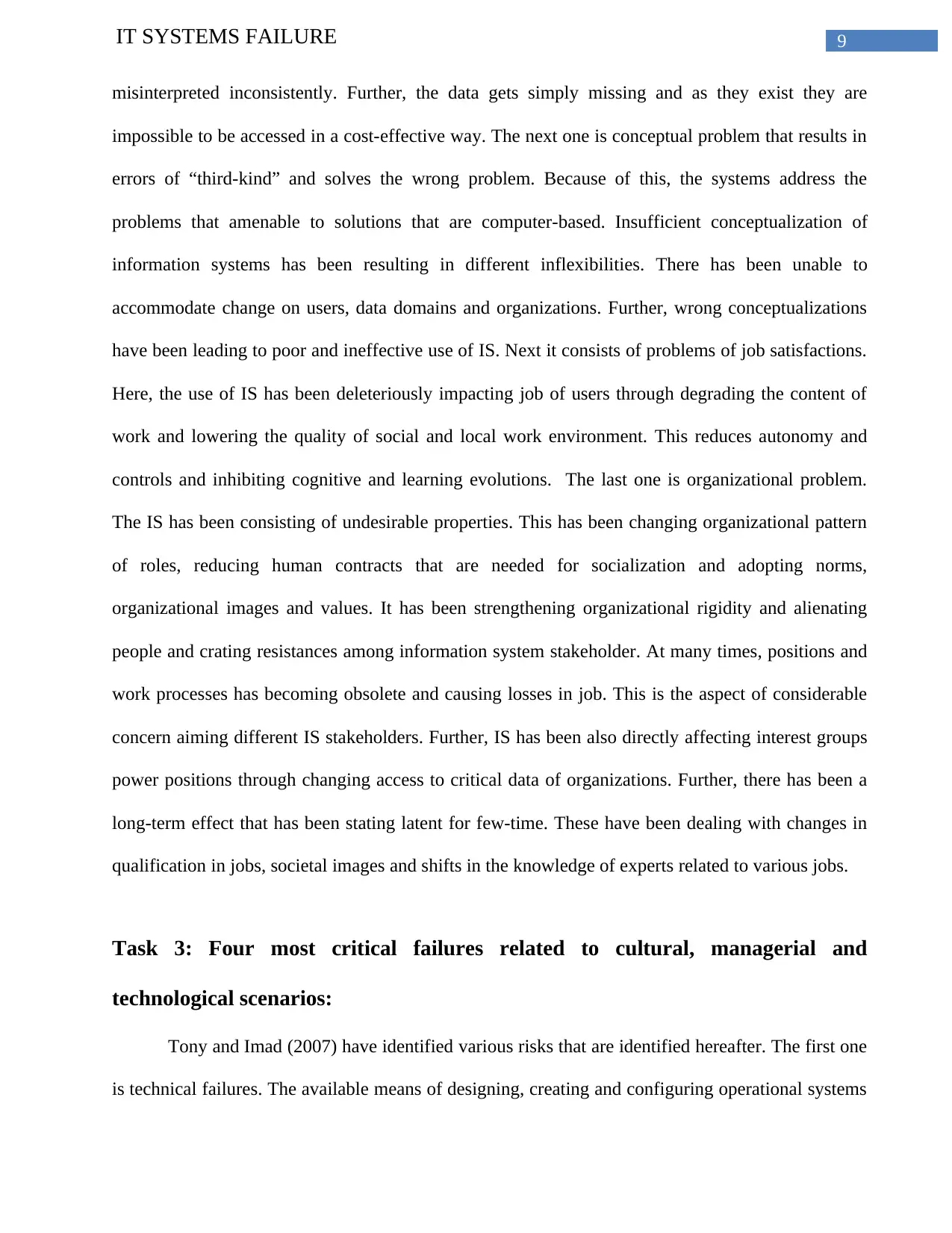
9IT SYSTEMS FAILURE
misinterpreted inconsistently. Further, the data gets simply missing and as they exist they are
impossible to be accessed in a cost-effective way. The next one is conceptual problem that results in
errors of “third-kind” and solves the wrong problem. Because of this, the systems address the
problems that amenable to solutions that are computer-based. Insufficient conceptualization of
information systems has been resulting in different inflexibilities. There has been unable to
accommodate change on users, data domains and organizations. Further, wrong conceptualizations
have been leading to poor and ineffective use of IS. Next it consists of problems of job satisfactions.
Here, the use of IS has been deleteriously impacting job of users through degrading the content of
work and lowering the quality of social and local work environment. This reduces autonomy and
controls and inhibiting cognitive and learning evolutions. The last one is organizational problem.
The IS has been consisting of undesirable properties. This has been changing organizational pattern
of roles, reducing human contracts that are needed for socialization and adopting norms,
organizational images and values. It has been strengthening organizational rigidity and alienating
people and crating resistances among information system stakeholder. At many times, positions and
work processes has becoming obsolete and causing losses in job. This is the aspect of considerable
concern aiming different IS stakeholders. Further, IS has been also directly affecting interest groups
power positions through changing access to critical data of organizations. Further, there has been a
long-term effect that has been stating latent for few-time. These have been dealing with changes in
qualification in jobs, societal images and shifts in the knowledge of experts related to various jobs.
Task 3: Four most critical failures related to cultural, managerial and
technological scenarios:
Tony and Imad (2007) have identified various risks that are identified hereafter. The first one
is technical failures. The available means of designing, creating and configuring operational systems
misinterpreted inconsistently. Further, the data gets simply missing and as they exist they are
impossible to be accessed in a cost-effective way. The next one is conceptual problem that results in
errors of “third-kind” and solves the wrong problem. Because of this, the systems address the
problems that amenable to solutions that are computer-based. Insufficient conceptualization of
information systems has been resulting in different inflexibilities. There has been unable to
accommodate change on users, data domains and organizations. Further, wrong conceptualizations
have been leading to poor and ineffective use of IS. Next it consists of problems of job satisfactions.
Here, the use of IS has been deleteriously impacting job of users through degrading the content of
work and lowering the quality of social and local work environment. This reduces autonomy and
controls and inhibiting cognitive and learning evolutions. The last one is organizational problem.
The IS has been consisting of undesirable properties. This has been changing organizational pattern
of roles, reducing human contracts that are needed for socialization and adopting norms,
organizational images and values. It has been strengthening organizational rigidity and alienating
people and crating resistances among information system stakeholder. At many times, positions and
work processes has becoming obsolete and causing losses in job. This is the aspect of considerable
concern aiming different IS stakeholders. Further, IS has been also directly affecting interest groups
power positions through changing access to critical data of organizations. Further, there has been a
long-term effect that has been stating latent for few-time. These have been dealing with changes in
qualification in jobs, societal images and shifts in the knowledge of experts related to various jobs.
Task 3: Four most critical failures related to cultural, managerial and
technological scenarios:
Tony and Imad (2007) have identified various risks that are identified hereafter. The first one
is technical failures. The available means of designing, creating and configuring operational systems
Paraphrase This Document
Need a fresh take? Get an instant paraphrase of this document with our AI Paraphraser
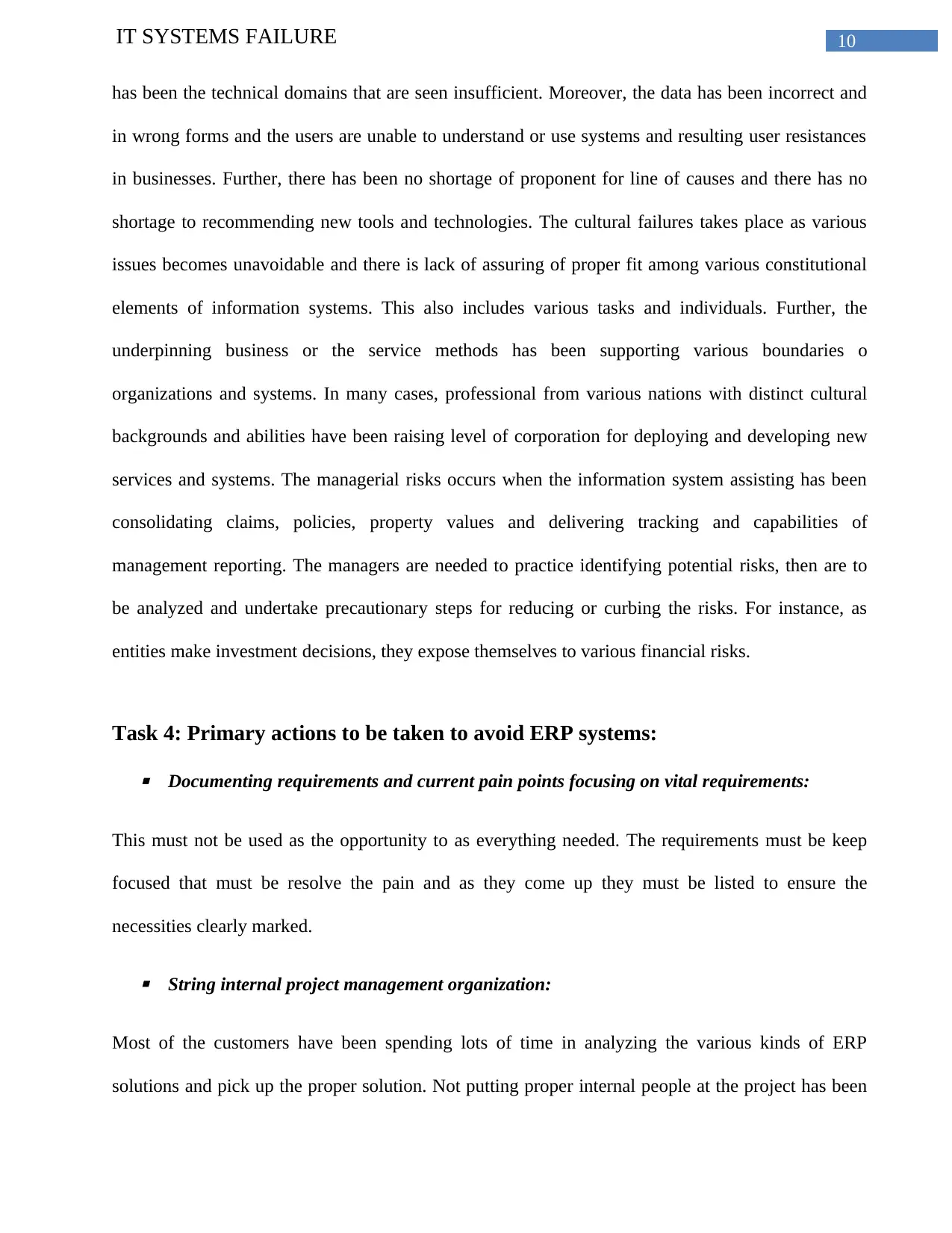
10IT SYSTEMS FAILURE
has been the technical domains that are seen insufficient. Moreover, the data has been incorrect and
in wrong forms and the users are unable to understand or use systems and resulting user resistances
in businesses. Further, there has been no shortage of proponent for line of causes and there has no
shortage to recommending new tools and technologies. The cultural failures takes place as various
issues becomes unavoidable and there is lack of assuring of proper fit among various constitutional
elements of information systems. This also includes various tasks and individuals. Further, the
underpinning business or the service methods has been supporting various boundaries o
organizations and systems. In many cases, professional from various nations with distinct cultural
backgrounds and abilities have been raising level of corporation for deploying and developing new
services and systems. The managerial risks occurs when the information system assisting has been
consolidating claims, policies, property values and delivering tracking and capabilities of
management reporting. The managers are needed to practice identifying potential risks, then are to
be analyzed and undertake precautionary steps for reducing or curbing the risks. For instance, as
entities make investment decisions, they expose themselves to various financial risks.
Task 4: Primary actions to be taken to avoid ERP systems: Documenting requirements and current pain points focusing on vital requirements:
This must not be used as the opportunity to as everything needed. The requirements must be keep
focused that must be resolve the pain and as they come up they must be listed to ensure the
necessities clearly marked.
String internal project management organization:
Most of the customers have been spending lots of time in analyzing the various kinds of ERP
solutions and pick up the proper solution. Not putting proper internal people at the project has been
has been the technical domains that are seen insufficient. Moreover, the data has been incorrect and
in wrong forms and the users are unable to understand or use systems and resulting user resistances
in businesses. Further, there has been no shortage of proponent for line of causes and there has no
shortage to recommending new tools and technologies. The cultural failures takes place as various
issues becomes unavoidable and there is lack of assuring of proper fit among various constitutional
elements of information systems. This also includes various tasks and individuals. Further, the
underpinning business or the service methods has been supporting various boundaries o
organizations and systems. In many cases, professional from various nations with distinct cultural
backgrounds and abilities have been raising level of corporation for deploying and developing new
services and systems. The managerial risks occurs when the information system assisting has been
consolidating claims, policies, property values and delivering tracking and capabilities of
management reporting. The managers are needed to practice identifying potential risks, then are to
be analyzed and undertake precautionary steps for reducing or curbing the risks. For instance, as
entities make investment decisions, they expose themselves to various financial risks.
Task 4: Primary actions to be taken to avoid ERP systems: Documenting requirements and current pain points focusing on vital requirements:
This must not be used as the opportunity to as everything needed. The requirements must be keep
focused that must be resolve the pain and as they come up they must be listed to ensure the
necessities clearly marked.
String internal project management organization:
Most of the customers have been spending lots of time in analyzing the various kinds of ERP
solutions and pick up the proper solution. Not putting proper internal people at the project has been
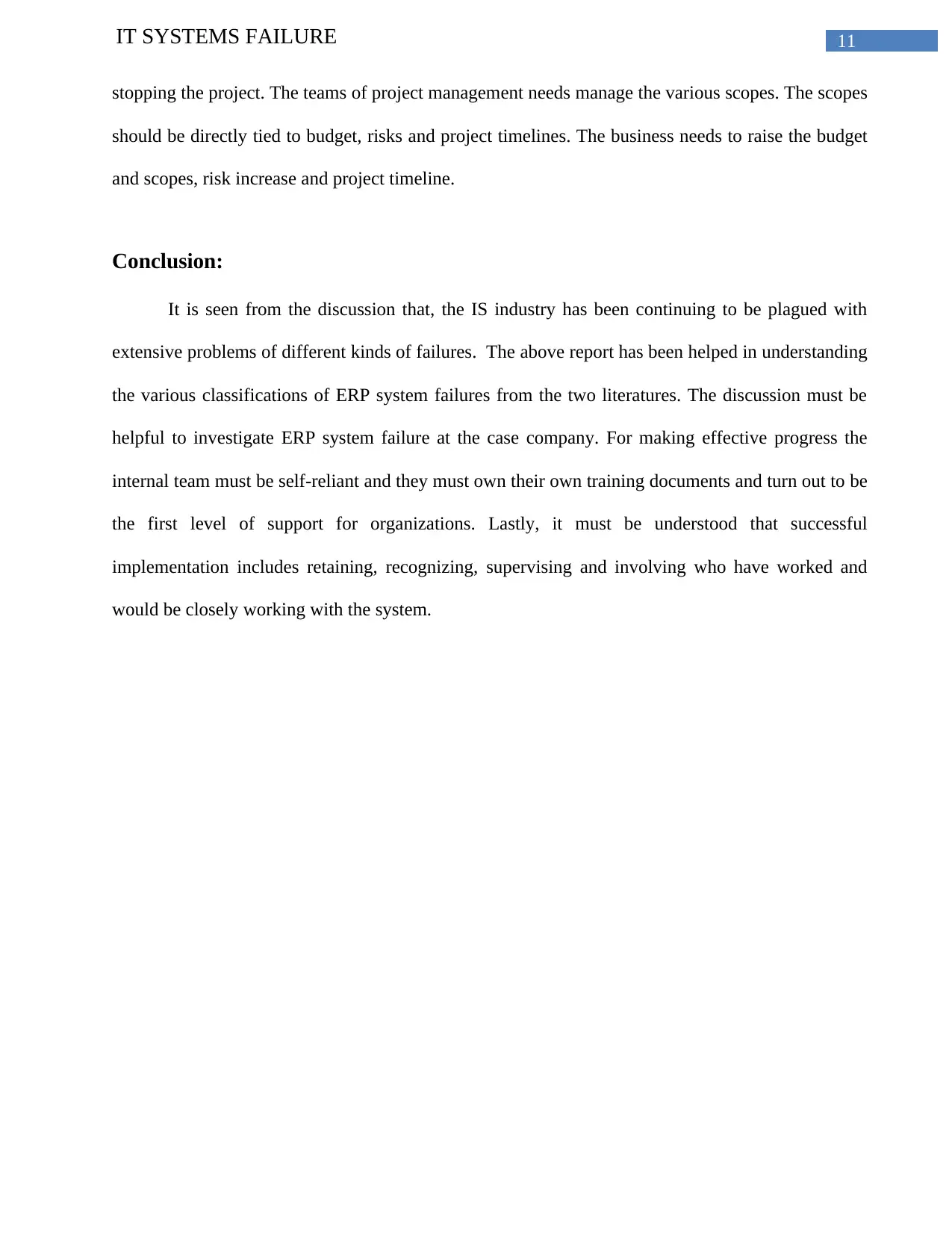
11IT SYSTEMS FAILURE
stopping the project. The teams of project management needs manage the various scopes. The scopes
should be directly tied to budget, risks and project timelines. The business needs to raise the budget
and scopes, risk increase and project timeline.
Conclusion:
It is seen from the discussion that, the IS industry has been continuing to be plagued with
extensive problems of different kinds of failures. The above report has been helped in understanding
the various classifications of ERP system failures from the two literatures. The discussion must be
helpful to investigate ERP system failure at the case company. For making effective progress the
internal team must be self-reliant and they must own their own training documents and turn out to be
the first level of support for organizations. Lastly, it must be understood that successful
implementation includes retaining, recognizing, supervising and involving who have worked and
would be closely working with the system.
stopping the project. The teams of project management needs manage the various scopes. The scopes
should be directly tied to budget, risks and project timelines. The business needs to raise the budget
and scopes, risk increase and project timeline.
Conclusion:
It is seen from the discussion that, the IS industry has been continuing to be plagued with
extensive problems of different kinds of failures. The above report has been helped in understanding
the various classifications of ERP system failures from the two literatures. The discussion must be
helpful to investigate ERP system failure at the case company. For making effective progress the
internal team must be self-reliant and they must own their own training documents and turn out to be
the first level of support for organizations. Lastly, it must be understood that successful
implementation includes retaining, recognizing, supervising and involving who have worked and
would be closely working with the system.
⊘ This is a preview!⊘
Do you want full access?
Subscribe today to unlock all pages.

Trusted by 1+ million students worldwide
1 out of 12
Related Documents
Your All-in-One AI-Powered Toolkit for Academic Success.
+13062052269
info@desklib.com
Available 24*7 on WhatsApp / Email
![[object Object]](/_next/static/media/star-bottom.7253800d.svg)
Unlock your academic potential
Copyright © 2020–2025 A2Z Services. All Rights Reserved. Developed and managed by ZUCOL.





